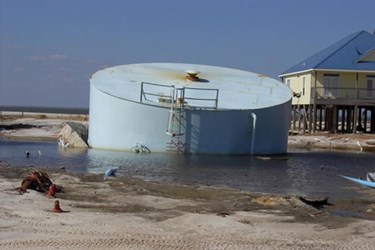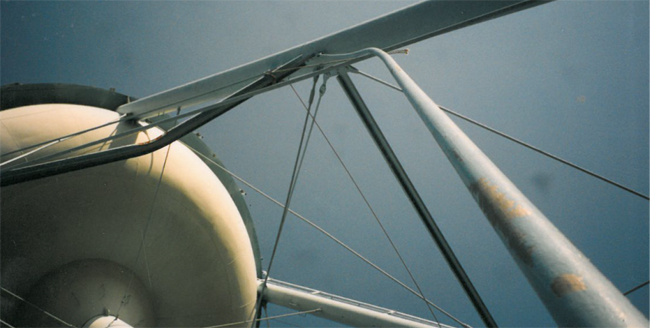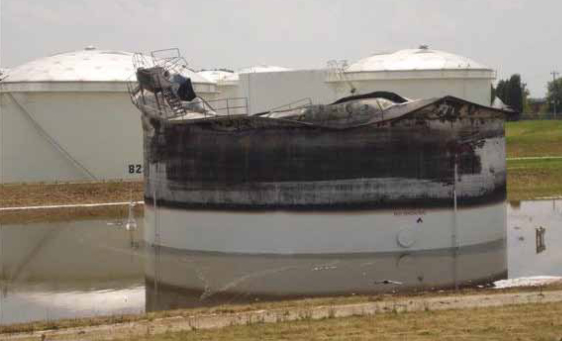Water Tanks And Severe Weather

By Erika Henderson, Pittsburg Tank & Tower Group
Severe weather can be devastating, and, according to numerous weather sources, is occurring more frequently and widespread. Tornadoes are now occurring anywhere from the Rockies to the East Coast. Currently, the southern Pacific coast is experiencing a severe drought, many areas in the east coast are flooded, and thousands of people were killed in the Nepal earthquake.
Severe weather does not discriminate and can damage or destroy everything in its path, including water tanks. Necessary water supply for consumption, fire protection, and emergency needs is crucial to everyday well-being, and even more when a severe weather event occurs. Therefore, water tanks should be designed, constructed, maintained, and inspected to withstand severe weather.
Tanks that have experienced winter storms and freezing should obviously be inspected for damage, but seismic activity, high winds, lightning, droughts, and flooding also occur in the summer months, and tanks are susceptible to damage from them as well.
High Winds/Lightning Strikes
The National Fire Protection Association (NFPA) states, “Anchor bolts shall be arranged to securely engage a weight at least equal to the net uplift when the tank is empty and the wind is blowing from any direction.” 1 Lightweight tanks definitely need to be anchored against high winds in areas that experience them, and elevated water tanks should have their windage rods inspected and tightened regularly to maintain winds of 150 mph, blowing from any direction.

Damaged windage rods
Tanks not grounded are subject to lightning damage. Lightning strikes could cause power outages that could affect the ability to receive water. Water pumps and alarms could malfunction, or a complete tank failure could occur. NFPA 780 states, “Tanks shall be grounded to conduct away the current of direct strokes and the buildup and potential that cause sparks to ground.” 2

Groundwater storage tank struck by lightning
Drought/Flooding
When a drought occurs, aggressive water conservation measures are often taken; but tanks still need to be inspected and cleaned. To conserve precious water, Robotic operated vehicles (ROVs) can be used to inspect and clean tanks without draining them, thus saving the water.
Foundation damage can easily occur if tanks are subjected to flooding for prolonged periods. Tank sites should have good drainage to minimize or prevent possible foundation damage from flooding. The site design should also include provisions for draining the tank and the discharge from the tank overflow without damaging the tank site or neighboring properties.
Seismic Activity
Tanks are designed and constructed for resisting earthquake damage by complying with the earthquake design load provisions of American Water Works Association (AWWA), in accordance with its Seismic Use Group (SUG) and site class. The SUG is a classification assigned to a tank based on its intended use and expected performance; tanks that serve multiple facilities use the highest SUG. Site class accounts for the effect of local soil conditions on the ground motion and are based on the soil present and their engineering properties as established by a geotechnical investigation. The SUG and site class help determine the appropriate freeboard and the number of anchor bolts needed. Freeboard is the distance from the maximum operating level (MOL) to the lowest level of the roof framing and is determined by the sloshing wave height that could occur.3 Freeboard is taken into consideration to prevent a tank from overturning or causing roof damage due to sloshing.
The design of the piping system connected to the tank should consider the effects of foundation movements and potential movement of the connection points during earthquakes. Sufficient flexibility should be provided to avoid release of the tank contents due to failure of the piping system. The piping system and supports shall be designed so as not to impart significant mechanical loading on the attachments of the tank. Mechanical devices that add flexibility, such as bellows, expansion joints, and other flexible apparatuses, may be used when designed for the seismic displacements and defined operating pressure.4
What to Look For
Water tanks should be inspected regularly for proper working order and stability before severe weather hits. Overhead obstructions, trees, and overgrowth that could puncture or damage a tank during severe weather should be removed, and operators should routinely look for foundation, wind, and earthquake damage. Such damage on tower-supported tanks may be indicated by cracked coating or welds at the tower connections; broken, bent, or sagging rods; buckled struts; dented or twisted columns; or missing or loose rod pins. If any of these conditions are observed, the tank should be professionally inspected. In addition, tanks in areas at high risk for wind or earthquake damage should be inspected more frequently than tanks in low risk areas.5
References
1. National Fire Protection Association, NFPA-22 Standard for Water Tanks for Private Fire Protection. 2013
2. National Fire Protection Association, NFPA-780 Standard for the Installation of Lightning Protection Systems. 2014.
3-4. American Water Works Association, D100-11 Welded Carbon Steel Tanks for Water Storage. 2011.
5. American Water Works Association, M42 Steel Water Storage Tanks. 2013.
